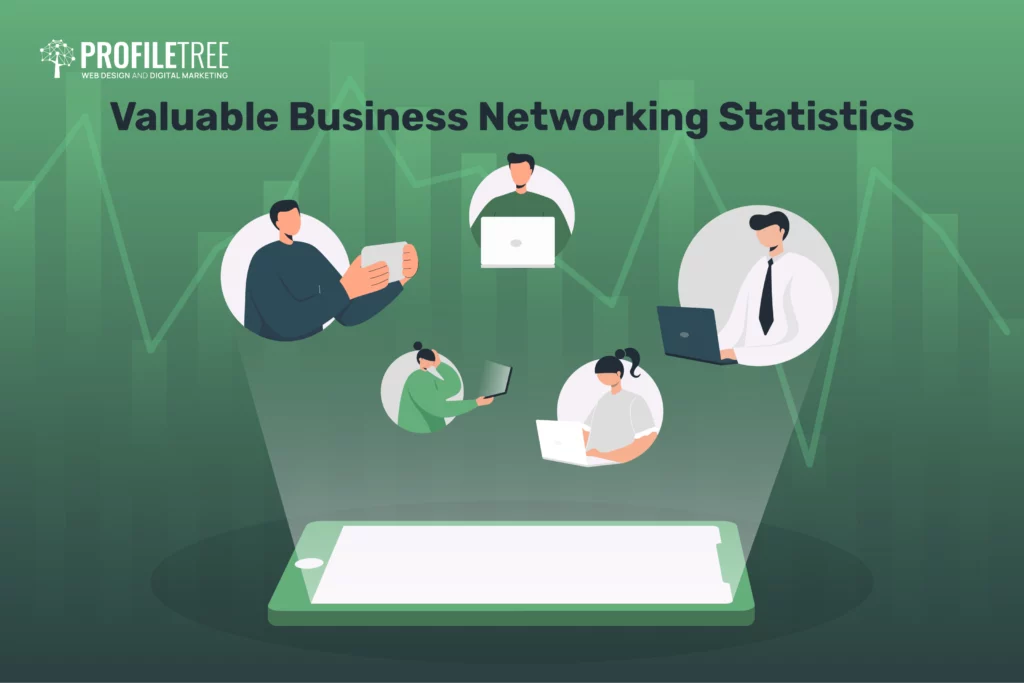In our professional lives, the value of personal connections transcends mere resumes and online profiles. Building a solid network – a web of mutually beneficial relationships—has become a critical factor in career advancement, business success for business owners, and unlocking hidden opportunities.
This article dives into the intriguing world of business networking statistics, offering concrete data and valuable insights to guide your networking strategy and drive career success for small business owners. We’ll unearth the underlying figures that signify the power of business connections, from the frequency of networking in securing job opportunities to the conversion rates of face-to-face networking encounters.

What Is Business Networking?
Business networking intentionally nurtures mutually beneficial business relationships with other industry professionals, business owners, and organisations. This encompasses not just colleagues or direct contacts but also your online network and business card contacts.
Business networking contains a wider web of people who can potentially open doors, especially for small business owners, share knowledge through social media platforms, and offer career-boosting opportunities through in-person networking activities.
Key Benefits of Networking
- Landing your dream job: Up to 70% of positions are filled through personal connections.
- Generating leads and building business: Networks are goldmines for referrals, client introductions, and valuable partnerships.
- Gaining knowledge and expertise: Mentorship, industry trends, and collaborative ideas flow freely through solid networks.
- Accelerating career advancement: Access to insider information, career advice, and opportunities often arise through trusted connections.
Impact of the Pandemic on Business Networking Statistics
The COVID-19 pandemic threw a curveball at the once-familiar world of business networking. Handshakes were replaced with emojis, conference rooms with Zoom squares, and bustling industry events with pixelated webinars.
Did this sudden shift to virtual interactions sound the death knell for in-person networking? Absolutely not! Instead, it sparked a fascinating evolution: the rise of hybrid solutions.
While a yearning for face-to-face connections remains strong (a whopping 68% of professionals prefer it, according to Zippia), virtual platforms’ convenience and global reach can’t be ignored. This has led to a beautiful blending of both worlds, with fascinating statistics to back it up:
- 70% of event planners in 2022 opted for hybrid models at conferences and meetings, recognising the value of catering to both in-person and virtual audiences (Skift Meetings).
- 83% of event organisers and 78% of attendees believe in-person conferences provide the ideal networking environment, highlighting the continued importance of real-world connections (Bizzabo).
- 46% of job seekers used online platforms like LinkedIn to find or learn about open positions, showcasing the effectiveness of virtual channels in the job search (Jobvite).
Exploring Latest Trends in Business Networking Statistics 2023
The world of business networking is dynamic and constantly evolving according to professional needs and technological advancements. As we navigate the tail end of 2023, let’s unravel some of the most captivating trends emerging from the ever-evolving realm of connections and statistics:
1. Hybrid Dominance
While the allure of face-to-face interactions remains undeniable, 2023 has strengthened the reliance on hybrid networking. A recent Bizzabo report reveals that 82% of event organisers now prioritise hybrid experiences, recognising the value of reaching both physical and virtual audiences.
This trend applies not just to conferences but also to casual coffee chats facilitated by platforms like Lunchclub, which enable quick online meet-ups across geographical boundaries.
2. Micro-Networking’s Mighty Rise
Forget about sprawling mega-groups—smaller, focused gatherings are gaining traction. LinkedIn groups buzz with activity, fostering niche and targeted discussions that lead to deeper connections among like-minded professionals. This shift caters to individuals seeking focused knowledge sharing and collaboration within specific areas of expertise.
3. Metrics that Matter
The data-driven business world also permeates networking. Platforms like LinkedIn Sales Navigator now offer detailed connection insights, highlighting shared interests, mutual connections, and engagement patterns. This allows professionals to strategise their networking efforts, prioritising connections with the highest potential for value.
4. AI-Powered Matchmaking
Technology is stepping in to play Cupid professionally. Tools like Ideal and HiHello utilise AI algorithms to match individuals based on shared interests, career goals, and skill sets. This automation takes the guesswork out of networking, facilitating introductions that could spark fruitful collaborations.
5. Gamification Takes Center Stage
Remember the thrill of collecting Pokemon cards or levelling up in video games? That sense of achievement is now being applied to networking through gamified platforms.
Companies like Teambuilding.com offer points and badges for attending events, participating in discussions, and engaging with peers. This playful approach motivates individuals to engage in networking actively, fostering a more dynamic and participatory environment.
6. Micro-Influencers and Community Champions
As social media continues to reshape communication, micro-influencers and community champions emerge as influential players in professional networking. These individuals, often niche industry experts, leverage their online platforms to build engaged communities, offering valuable insights and facilitating connections among their followers.
7. Beyond the Binary: Embracing Neurodiversity
Networking can be challenging for individuals with neurodiverse profiles like ADHD or autism. 2023 witnessed a growing awareness of these challenges, with platforms offering features like asynchronous communication and quiet spaces at events to cater to diverse needs. This inclusivity fosters a more accessible and welcoming networking environment for all.
Online vs. Offline Networking: Building Bridges in the Digital Age
Now, let us move to another dimension of our debate in networking, which is online vs. offline. Both approaches offer unique advantages and drawbacks, leaving professionals torn between the warmth of face-to-face interactions and the vast reach of the digital world. Let’s dive into the pros and cons of each, helping you navigate the ever-evolving landscape of building meaningful connections.
Offline Networking (Pros)
- Deeper Connections: The human touch builds trust, rapport, and a deeper understanding of individuals, crucial for fostering long-term relationships.
- Body Language Cues: Non-verbal communication plays a significant role in forming first impressions and understanding genuine interest. In-person interactions provide valuable insights that can be lost online.
- Spontaneous Opportunities: Chance encounters at conferences, industry events, or even casual coffee shops can lead to unexpected connections and fruitful collaborations.
Offline Networking (Cons)
- Limited Reach: Geographical barriers and time constraints restrict offline networking, making connecting with professionals outside your immediate proximity challenging.
- Scheduling Challenges: Coordinating schedules for in-person meetings can be a logistical nightmare, especially across different time zones.
- Cost and Time Investment: Travel, accommodation, and event fees can add up, making offline networking a resource-intensive endeavour.
Online Networking (Pros)
- Global Reach: Platforms like LinkedIn connect you with professionals worldwide, opening doors to diverse opportunities and collaborations beyond geographical limitations.
- Time and Cost Efficiency: Virtual meetings and online interactions save time and travel expenses, making networking more accessible and convenient.
- Targeted Approach: Advanced search filters on networking platforms allow you to find individuals with specific skills or expertise, streamlining your search for valuable connections.
Online Networking (Cons)
- Superficial Connections: The lack of physical presence can make building deep rapport and trust difficult, leading to more impersonal and transactional interactions.
- Miscommunication Risks: Communication through text or video can lead to misunderstandings due to misinterpretations of tone and non-verbal cues.
- Information Overload: The sheer volume of connections and platforms can be confusing, making it difficult to focus on building meaningful relationships.
The Hybrid Solution
The real magic lies in embracing a hybrid approach, leveraging the strengths of both online and offline networking. Attend industry events for personal interactions and build your online presence through platforms like LinkedIn. Also, participate in online discussions to expand your reach and seek out in-person meetings with promising connections
The Rise of Online Networking Platforms
The 2023 networking statistics reveal a surge in utilising online networking platforms such as LinkedIn and other social media sites. Professionals are increasingly tapping into the potential of virtual networking to expand their circle of professional connections and explore new business opportunities.
Today, the rise of online networking platforms has facilitated a new community of virtual connections, reshaping how we build relationships and advance our careers. These platforms are catalysts for:
1. Global Reach
No longer limited by geographical boundaries, professionals can now connect with like-minded individuals and potential collaborators across the globe. Imagine the possibilities of brainstorming with a tech expert in Silicon Valley while sipping your morning coffee in Cairo!
2. Targeted Connections
Advanced search filters on platforms like LinkedIn allow you to pinpoint individuals with specific skills, experience, or even interests, ensuring your time and efforts are invested in building precious connections.
3. Building Communities
Niche platforms and online groups have fostered vibrant communities around specific industries, professions, or even shared passions. These communities provide a safe space for knowledge sharing, mentorship, and collaboration, nurturing a sense of belonging and mutual support.
4. Breaking Down Barriers
For introverts and individuals from underrepresented groups, online platforms offer a more comfortable and accessible space to network. The ability to connect at your own pace and on your own terms empowers everyone to participate and build meaningful relationships.
5. Continuous Engagement
Unlike fleeting conference interactions, online platforms allow for ongoing communication and relationship building. You can engage in discussions, share articles, and provide mutual support, keeping your connections warm and active over time.
Benefits of In-Person Networking

While the digital revolution has transformed our world, the magic touch of in-person networking remains an undeniably powerful tool in building your professional network. While online platforms offer undeniable reach and convenience, face-to-face interactions provide unmatched depth, trust, and a sense of human connection that can truly propel your career forward. Here’s why:
1. Deeper Connections
There’s something intangible about shaking hands, making eye contact, and reading body language that simply can’t be replicated online. These nuanced interactions foster trust, rapport, and a genuine understanding that lays the foundation for long-term, mutually beneficial relationships.
2. Spontaneous Opportunities
The serendipitous encounters at conferences, industry events, or even casual coffee shops can lead to unexpected connections and unforeseen opportunities. A chance conversation with a seasoned professional could open doors you never knew existed, serendipitously propelling your career.
3. Skill-Building
In-person interactions hone your communication skills, allowing you to articulate your thoughts clearly, read social cues, and build confidence in expressing yourself in front of others. These skills transfer seamlessly to all aspects of your professional life, making you a more effective communicator and leader.
4. Enhanced Learning
Face-to-face discussions allow you to absorb information and insights more deeply. Participating in panel discussions, workshops, or brainstorming sessions provides a richer learning experience than passively consuming content online.
5. Team Building and Collaboration
In-person interactions foster a sense of camaraderie and understanding that strengthens teamwork and collaboration. Building rapport with colleagues and partners offline translates into more effective teamwork and cohesive collaboration in the virtual world.
So, step out of your comfort zone and explore the diverse world of business networking possibilities. Whether you embrace the boundless reach of online platforms or the warmth of face-to-face interactions, the key lies in authenticity, intentionality, and a willingness to build genuine relationships.
Be strategic in your approach, nurture your connections with time and effort, and remember that even the most unexpected encounters can spark career-defining opportunities.
FAQS
What are the top niche online networking platforms?
Academia.edu and ResearchGate connect researchers and scholars. Doximity connects physicians and healthcare professionals. Avvo and LawLink connect lawyers and legal professionals.
What is a business network group?
A business network group is a community of professionals gathered to forge connections, share knowledge, and advance their careers. These groups come in various shapes and sizes, but all share the goal of fostering professional relationships and growth.
What are the types of business network groups?
The types of business network groups are casual contact groups, strong contact groups, professional associations, online networking platforms, and niche and special interest groups.
What are the best small business networking groups?
The best small business networking groups are SCORE, Entrepreneurs’ Organisation (EO), Business Networking International (BNI), Young Entrepreneur Council (YEC), American Marketing Association (AMA), LinkedIn groups, and Network After Work.


